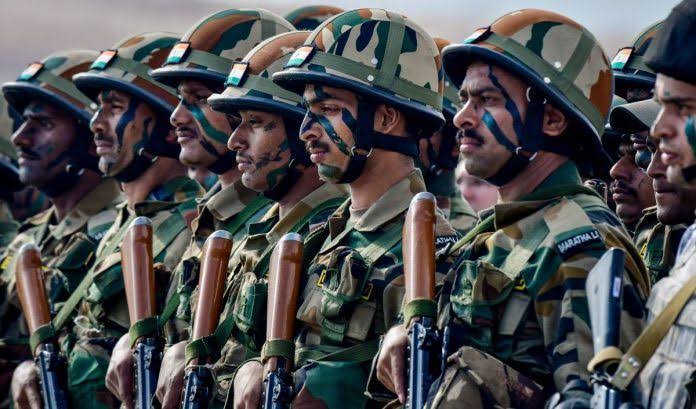Indian Army Must Increase Its Offensive Capabilities Along LAC In Ladakh
By
Colonel Awadhesh Kumar, Special Forces

The offensive capability against China required since 1962 came into being only in 2013 with the Commencement of raising of 17 Corps. After years of dithering on the subject, the cabinet committee, under the Congress Government, sanctioned the proposal, which had been already recommended by Chiefs of Staff Committee, to build the new mountain strike corps over a time span of seven years (12th plan period (2012–17). The Corp was planned to be raised with around 90000 soldiers and an expenditure of around Rs 64,700 crore had been sanctioned. Out of this budget, around Rs 39,000 crore had been earmarked for capital expenditure. Additional Rs 19,000 crore was also demanded for further development by the Army which was never given and even out of allotted 64K crores, most of it remained unspent by MoD and taken back by Finance Ministry.
By the time a new NDA Government under Prime Minister Narendra Modi took over the reigns, the MoD under the Congress Raksha Mantri had ensured that the entire defence machinery was in shambles. Money had to be found for so many things and all were URGENT and required by the defence forces as of yesterday.
However, in spite of all the urgencies elsewhere, the raising of 17 Corps was not scrapped, though due to acute budgeting crunches due to Rafale fighters etc, the raising was slowed down. The HQ was already in place at Panagarh in West Bengal. It was to have two high-altitude infantry divisions comprising 30,000-40,000 personnel, including special forces. All these are in place. Now the focus is on slowly building up one artillery division, independent armoured brigade, Aviation Brigade and the combat support engineering force and a sound logistic support system. After all neglect of several decades cannot be undone suddenly.
Though after the Galwan incident and subsequent actions in Ladakh, it has finally dawned on the MoD that to prevent further actions by China, apart from increased permanent deployment along the line of actual control (LAC) in eastern Ladakh, there is need of offensive capability too.
General MM Navarane recently confirmed that the PLA was refusing to disengage from Gogra, Hot Springs and Demchok, areas it had deployed over a year ago, following routine military exercises in Chinese Occupied Ladakh and on the adjoining Chinese Occupied Tibetan plateau.
It is common knowledge that China is rapidly upgrading its overall military infrastructure along the LAC including roads, troop billets, helipads and surface-to-air (SAM) missile bases in depth areas. India too is not lagging behind the Chinese military in this regard. So till the issue is settled ultimately by vacation of Occupied Ladakh by PLA, the Indian Army needs a strong permanent deployment. For the ultimate aim of liberating Pakistan Occupued Kashmir, Pakistan Occupied Gilgit Baltistan and achieving Tibetan independence, we also need a Mountain Strike Corps for J&K/ Ladakh.
The PLA got the shock of its life when their planned adventure in Galwan and later along rest of LAC went for a toss due to a very rapid and prompt build up by the Indian Army at both tactical and operational level.
With matching forces on both sides, the LAC has been converted into the line of control akin to LOC with Pakistan. Only the routine exchange of artillery, mortar and small arms fire are missing at least for now. This placement of men and material in this region is certainly going to be economically challenging for both sides but more so for the Chinese. This has been found out by the PLA because their logistics have to hauled from China right across occupied Tibet and into Occupied Ladakh. In fact after having to spend a very harsh winter, two Chinese divisions had to be rotated near simultaneously because the conscripted Chinese youngsters just could not cope up.
To save face, there is going to be no further Chinese withdrawal, as indicated by the PLA conducting its annual summer exercises, in the region adjacent to the LAC in Occupied Ladakh and partly in Occupied Tibet. The Indian Army, in the process of building up its infrastructure since 2014, has now started accelerating the same.
Though the additional infrastructure needed to be built, will be at great expense, it will not be an unproductive military activity. It will help also in transforming the entire Union Territory of Ladakh and launch it onto the path of speedy economic development. Soon most of the food items especially FRESH for the Defence Forces are likely to be sourced from Ladakh itself. New roads etc will give a further boost to tourism in the foreseeable future to both domestic and international.
We already have 14 Corps in Ladakh with two permanent divisions 3 Ing Division and 8 Mtn Division. A third division moved in to bolster the 14 Corps needs to placed permanently under HQ 14 Corps so that we have two divisions facing the 800 km long LAC with China and one division facing Pakistan Occupied Baltistan.
Along with the Independent Armoured brigade in Ladakh, there will now be a limited offensive capability available to 14 Corps if a fourth division is also moved immediately and placed at Nimmo where earlier in 1987,we had 28 Infantry Division. This division as Command reserve will provide the much needed offensive capability for taking the battle deep into Tibet. This Division will also be available for any operations for liberation of Baltistan or in the Kashmir Valley.
It has been heard that the Army is re-orienting two infantry divisions from one of the three Strike Corps in the plains, earmarked for Western, South Western and the Southern borders with Pakistan. Having three strike Corps for this Front is surely an overkill.
By 2025 when the tunnel at Shinkun La pass is ready and the all weather Manali -Darcha— Padam—Nimmu and Padam- Kargil road are fully operational then the fifth division too may be moved and stationed somewhere in the Suru Valley. The Corps HQ with the Corps troops may be stationed in Doda District of J& K. At that point of time, we may think of a new Command comprising 14 Corps, 15 Corps and the Mountain Strike Corps.
It is seen that only the Forward Posture intiated by General Sunderji had deterred the Chinese in 1986/87. However after that several set of drills were agreed from 1993 onwards between India and China to maintain Peace and Tranquility along the LAC and this prevailed till last year. At that time India had prudently and rightly accepted them, as financially and militarily, it could ill afford to oversee the LAC, like it actively did the LoC with a much weaker Pakistan. However where the Congress Governments failed was to carry on slowly but surely with the build up and up gradation as per the then existing defence plans. Instead of listening to the defence Chiefs the Congress Government preferred to play to the Self Styled defence analysts and the bureaucracy.
The Chinese moves show that mere positioning of a few posts of a force like ITBP for monitoring of the vast expanses of LAC is a very bad idea indeed. These posts have to be sited and organized for all round defence and must function under the operational control of the Army. There can be no dual control whatsoever. Also 14 Corps must be allotted with adequate helicopter and unmanned aerial vehicles (UAVs) fleet and access to satellite surveillance.
Thus apart from providing limited offensive capability to 14 Corps, we finally need to build up a Corps size offensive capability in Ladakh/ Kashmir, along with requisite air support. Only this is going to deter China and bring it to the negotiating table for resolving both the issue of Chinese Occupied Ladakh and giving freedom to the Tibetan people.




